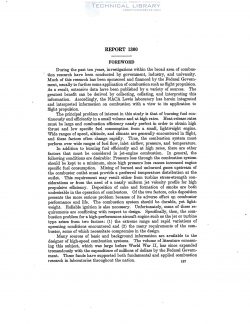naca-report-1300
- Version
- 359 Downloads
- 23.16 MB File Size
- 1 File Count
- November 2, 2016 Create Date
- November 2, 2016 Last Updated
National Advisory Committee for Aeronautics, Report - Basic Considerations in the Combustion of Hydrocarbon Fuels with Air

During the past ten years, investigations within the broad area of combustion
research have been conducted by government, industry, and university.
Much of this research has been sponsored and financed by the Federal Govern-
ment, usually to further some application of combustion such as flight propulsion.
As a result, extensive data have been published by a variety of sources. The
greatest benefit can be derived by collecting, collating, and interpreting this
information. Accordingly, the NACA. Lewis laboratory has herein integrated
and interpreted information on combustion with a view to its application to
flight propulsion.
The principal problem of interest in this study is that of burning fuel con-
tinuously and efliciently in a small volume and at high rates. Heat-release rates
must be large and combustion efliciency nearly perfect in order to obtain high
thrust and low specific fuel consumption from a small, lightweight engine.
Wide ranges of speed, altitude, and climate are generally encountered in flight,
and these factors often change rapidly. Thus, the combustion system must
perform over wide ranges of fuel flow, inlet airflow, pressure, and temperature.
In addition to burning fuel efliciently and at high rates, there are other
factors that must be considered in jet-engine combustion. In general, the
following conditions are desirable: Pressure loss through the combustion system
should be kept to a minimum, since high pressure loss causes increased engine
specific fuel consumption. Mixing of burned and unburned gases upstream of
the combustor outlet must provide a preferred temperature distribution at the
outlet. This requirement may result either from turbine stress-strength con-
siderations or from the need of a nearly uniform jet velocity profile for high
propulsive efliciency. Deposition of coke and formation of smoke are both
undesirable in the operation of combustors. Of the two factors, coke deposition
presents the more serious problem because of its adverse effect o_n combustor
performance and life. The combustion system should be durable, yet light-
weight. Reliable ignition is also necessary. Unfortunately, some of these re-
quirements are conflicting with respect to design. Specifically, then, the com-
bustion problem for a high~performance aircraft engine such as the jet or turbine
type arises from two factors: (1) the extreme range and rapid variations of
operating conditions encountered and (2) the many requirements of the com-
bustor, some of which necessitate compromise in the design.
Many sources of basic and background information are available to the
designer of high-speed combustion systems. The volume of literature concern-
ing this subject, which was large before World War II, has since expanded
tremendously with the expenditure of millions of dollars by the Federal Govern-
ment. These funds have supported both fundamental and applied combustion
research in laboratories throughout the nation.
| File | Action |
|---|---|
| naca-report-1300 Basic Considerations in the Combustion of Hydrocarbon Fuels with Air.pdf | Download |

Comment On This Post